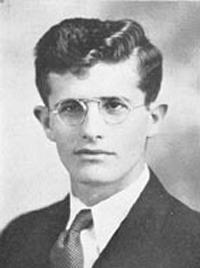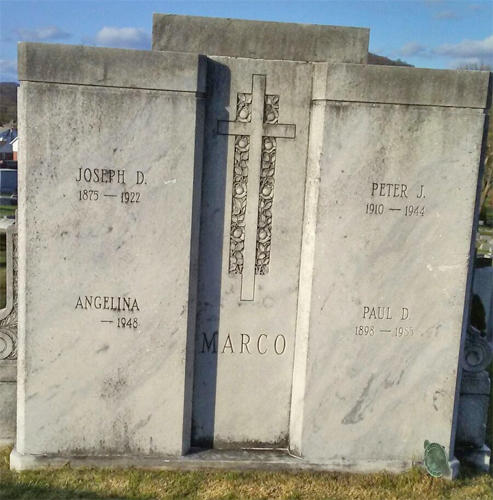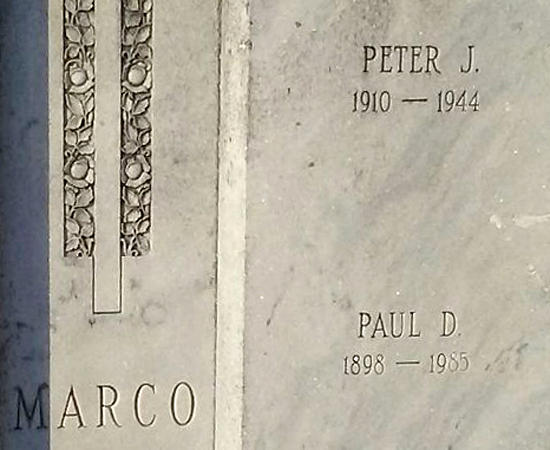

Peter J. Marco
Company A 1st Battalion 2nd Infantry
4th Infantry Division
KIA 09/20/1944
Peter Joseph Marco was born in Berks County, Pennsylvania on December 12, 1910.
He was drafted into the Army at
New Cumberland, Pennsylvania on June 4, 1941. He had completed
four years of college,
and listed his civilian occupation as lawyer. He was single, with
no dependents.
His religion was listed as Catholic.
He was released by the Army on
October 14, 1941 due to the fact that when he was drafted he was
actually beyond the draft age limit of 28 years old. After the
United States entered the war he was
recalled to active duty on April 20, 1942.
Marco graduated from Officers Candidate School in December 1942 and was commissioned a 2nd Lieutenant.
He was promoted to 1st Lieutenant on September 14, 1943.
1st Lieutenant Peter J. Marco
was wounded and listed as Missing In Action in Germany,
on September 17, 1944, during 1st Battalion's attack against the
town of Sellerich. On
September 20, 1944 his status was changed to Killed In Action.
First Battalion led the 22nd
Infantry's attack on Sellerich on September 17, with tanks and
tank destroyers
as support. Second Battalion attacked Hill 583 to the north of
Sellerich, and Third Battalion was engaged
in the battle for Brandscheid, to the southwest of Sellerich.
Major Robert Latimer, commanding 1st Battalion,
could not take the best approach to the town because of the
continuing fight around Brandscheid, and was
therefore forced to approach Sellerich through an open draw.
Though the attack would have to be pursued
through murderous fire from three sides, Latimer had been ordered
by the Regimental Commander,
Colonel Charles Lanham, to advance and take the town of Sellerich
no matter what the cost.
Captain Haskett, commanding
Company A, had previously experienced a close call from artillery
fire, and was badly shaken up.
As he led Company A through German artillery, mortar and machine
gun fire, he watched his men being cut down
by the heavy fire. He became distraught and could no longer
function. Major Latimer instructed 1st Lieutenant
Peter J. Marco to assume command of Company A.
Marco led Company A to the high
ground just outside of Sellerich, where they attempted to dig in.
They were
hit by extremely heavy fire from the enemy, making their position
almost suicidal.
Marco
radioed Latimer that his men could not hold. Latimer replied that
reinforcements were on the way.
What he did not know was that the reinforcing unit, Company B,
was itself pinned down. Company C was also
under heavy fire, and moving it up would endanger the battalion's
flank. Marco was wounded at some point, and
Latimer eventually got Lanham's permission to get Company A out
the trap. Runners went forward to deliver the
message, but after some time passed and no word came from them,
the Battalion S-3 volunteered to go up. He was hit
five times while trying to reach the remnants of the isolated
company. He did not know that the survivors of Company A
had pulled out on their own. Casualties were apparently scattered
between the Schnee Eifel woods line and Hill 520.
Evacuation took several hours, and only two officers and
sixty-two men reached the rear.
Marco was listed as missing in action. ¹
Lt. Marco was born in 1910, in
Berks County, Pennsylvania, the son of Italian immigrants. He
graduated from
Birdsboro High School in 1929 and entered the College soon after.
He graduated with the class of 1932 and
immediately entered the Dickinson School of Law, from which he
received his LL.B. in 1935. While at College,
he was a member of Mohler Scientific Club and Theta Chi
fraternity. In June, 1936, he became the first Italian American
to be admitted to the Berks County Bar. After practicing law in
the county, he was inducted into the Army on June 4, 1941
and assigned to basic training in Georgia. In October, 1941, he
briefly won his release from selective service as he
was actually beyond the peacetime age for service. With the
outbreak of war, however, he was soon back in uniform.
He served as a sergeant of military police in Philadelphia during
mid 1942 but by December he had graduated from the
Infantry School at Fort Benning, Georgia and had been
commissioned. In June, 1944 he was assigned to a replacement
officer unit in England and was soon serving with Company A, 22nd
Infantry Regiment of the Fourth Division in the
hedgerow fighting through Normandy. On September 20, 1944, near
Aachen, in Germany, Peter Marco was first reported
missing in action and was later declared to have been killed.
From the Dickinson College webpage
Peter J. Marco was buried in the
temporary U.S. Military Cemetery,
Foy Cemetery, Bastogne, Belgium and some time later his remains
were returned to the United States where he was
reinterred in Pennsylvania on May 11, 1949.
Burial:
Gethsemane Cemetery
Laureldale
Berks County
Pennsylvania, USA
Plot: A-83-3

Burial monument for the Marco family. Peter's name is at the top right.
Photo by Kris Anthon from the Find A Grave website

The name of Peter J. Marco (at the top right) on the family monument.
Photo by Kris Anthon from the Find A Grave website
Top photo of Peter J. Marco by Jeff Hall from the Find A Grave website created by: Nancy Ziemba Gleaton
¹ Nothing
Less Than Full Victory: Americans At War In Europe by Edward
Miller,
Naval Institute Press , 2007 pp. 99
Home | Photos | Battles & History | Current |
Rosters & Reports | Medal of Honor | Killed
in Action |
Personnel Locator | Commanders | Station
List | Campaigns |
Honors | Insignia & Memorabilia | 4-42
Artillery | Taps |
What's New | Editorial | Links |